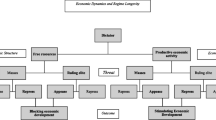Abstract
The paper extends and empirically tests GordonTullock's public choice theory of the nature of autocracy. A simple model of the relationship between constitutional rules governing succession in autocratic regimes and the occurrence of coups against autocrats is sketched. The model is applied to a case study of coups against monarchs in Denmark in the period ca. 935–1849. A clear connection is found between the specific constitutional rules governing succession and the frequency of coups. Specifically, the introduction of automatic hereditary succession inan autocracy provides stability and limits the number of coups conducted by contenders.
Similar content being viewed by others
References
Anderson, G. and Boettke, P.J. (1993). Perestroika and public choice: The economics of autocratic succession in a rent-seeking society. Public Choice 75: 101–118.
Dehn-Nielsen, H. (1996). Danmarks konger og regenter: Fra Hugleik til Margrethe 2. Copenhagen: Holkenfeldt.
Fabricius, K. (1920). Kongeloven: Dens tilblivelse og plads i samtidens natur-og arveretlige udvikling. Copenhagen: H. Hagerup.
Farran, C. D'O. (1960). Succession to Mohammedan thrones and titles. The Armorial 1: 69–73.
Jørgensen, P.J. (1947). Dansk retshistorie: Retskildernes og forfatningsrettens historie indtil sidste halvdel af det 17. aarhundrede. Second edition. Copenhagen: G.E.C. Gad, 1971.
Kurrild-Klitgaard, P. (1997). Rational choice, collective action and the paradox of rebellion. Ph.D. dissertation. Institute of Political Science, University of Copenhagen. Copenhagen: Politiske Studier.
McGuire, M.C. and Olson, M. Jr. (1996). The economics of autocracy and majority rule. Journal of Economic Literature 34: 72–96.
McKelvey, R.D. (1976). General conditions for global intransitivities in formal voting models. Econometrica 47: 1085–1112.
Morby, J.E. (1989). Dynasties of the world. Oxford: Oxford University Press.
Schofield, N. (1978). Instability of simple dynamic games. Review of Economic Studies 45: 575–594.
Shepsle, K.A. (1989). Studying institutions: Some lessons from the rational choice approach. Journal of Theoretical Politics 1: 131–147.
Tullock, G. (1971). The paradox of revolution. Public Choice 11: 89–100.
Tullock, G. (1974). The social dilemma: The economics of war and revolution. Blacksburg: Center for Study of Public Choice.
Tullock, G. (1981). Why so much stability? Public Choice 37: 189–202.
Tullock, G. (1987a). Autocracy. In G. Radnitzky and P. Bernholz (Eds.), Economic imperialism: The economic approach applied outside the field of economics, 365–381. New York: Paragon.
Tullock, G. (1987b). Autocracy. Dordrecht: Kluwer.
Author information
Authors and Affiliations
Rights and permissions
About this article
Cite this article
Kurrild-Klitgaard, P. The Constitutional Economics of Autocratic Succession. Public Choice 103, 63–84 (2000). https://doi.org/10.1023/A:1005078532251
Issue Date:
DOI: https://doi.org/10.1023/A:1005078532251



